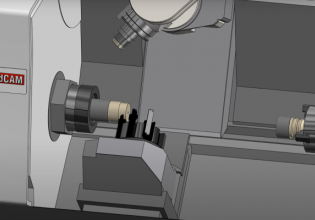Optomec Partners with Companies to Calculate ROI of Additive Manufacturing Tools for Gas Turbine Applications
The company just launched a new ROI tool to help engineers and companies decide which methods should be used during MRO’s.
Additive manufacturing company, Optomec, specializes in metal and microelectromechanical 3D printing technology.
Optomec utilizes methods such as their LENS Direct energy deposition tool, perfect for precision metal 3D prints or repairs on turbine parts. They also use their Aerosol Jet deposition method for creating electronic components down to the micron. This novel tool will save manufacturers a lot of expenses on parts that would otherwise need replacement or a lengthy multistep process to recreate.

The Aerosol Jet 5X System. Image courtesy of Optomec.
New Frontier of Overhaul
Since 3D printing companies have a lot of experience working with material science, Optomec understands that gas turbine parts require a great deal of structural calculation and general investment into manufacturing. Especially compressor wheels since they spin at high velocities, knowledge in metallurgy and physics will help the part obtain the optimal efficiency in a system.

LENS systems using a high power laser. Image courtesy of Optomec.
When these precision parts lose spec, it can be a pricey replacement. Optomec’s new ROI of the metal deposition method will steer MRO projects onto the right path. Using a customer-generated profile, Optomec can calculate the ROI of a repair job and decipher if the part should be repaired, recreated using laser cladding techniques, or recreated with traditional methods.
“Despite the fact that many MROs have moved to automated processes, the majority of turbine and compressor blade repair is still done manually today,” said Mr. Mike Dean, Marketing Director at Optomec. Optomec recognizes that there can be many contributing factors in developing a concept that supports automated laser cladding.
The overall goal was to help users understand the impact automation can have on the process. Dean also mentions, “In addition to the cost savings, there are huge benefits in terms of higher repeatability and superior metallurgy from automated laser cladding.”
Accelerating Industry
In order to use Optomec's new tool, all users need to do is visit their website and requesting a quote. As stated before, turbine parts require the utmost precision for proper operation, if Optomec achieves an MRO on these types of parts, then they must be able to repair another multitude of parts in other industries.
This tool is a gamechanger to the industry because it will determine if parts should require a much faster and in-expensive repair that will keep machines and other equipment running. This means less time for MRO and more time for system output.
Automated Laser Cladding Processes
Optomec's experience in additive manufactured microelectromechanical devices also paves the way for a new frontier in the field. Traditional multi-step deposition processes that require long cleanroom operation time and other equipment overhead to create a microelectromechanical device are now beginning to be rendered obsolete. This makes production times for micro parts decrease significantly resulting in increased volume output.
Through the use of Optomec's ROI tool, semiconductor plants could recognize the value of utilizing these industrial methods, and other industries can rethink and simplify MRO’s.






